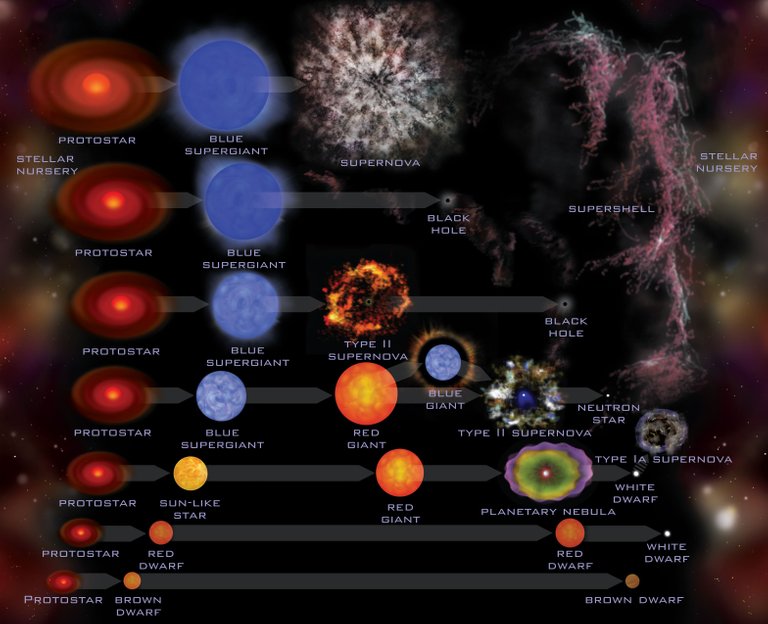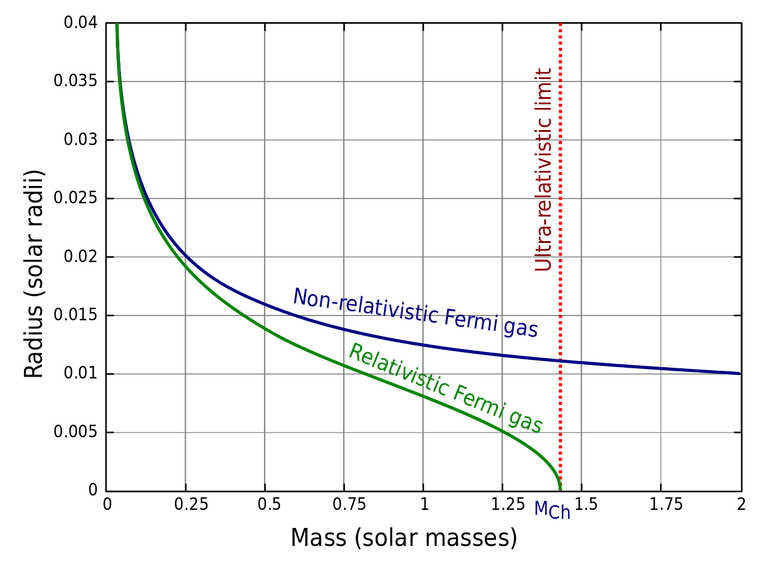In the first part of this post you could read about stellar evolution. This text will cover what happens after the unstable giant stages.
Depending on the mass that the star keeps after losing the outer layers after burning up all the fuel (up to iron), or gravitational collapse didn't provide high enough temperatures and density to start burning heavier elements, stars will end their life as white dwarf (M< 1.4M☉ ), neutron star (1.4M☉< 3M☉) or black hole (M>3M☉).

White Dwarfs
After red giant stadium and losing mass by blowing outer layers, low mass stars - like our Sun, which still have mass up to 1.4M⊙ will evolve into white dwarfs. When the star burns up its nuclear fuel in hydrostatic equilibrium breaks and the shrinking of the star starts again. If the star can't light up the heavier elements, it will continue to collapse until it is stopped by electron degeneracy pressure. Under the high pressure from the collapse atoms dissolve and matter loses its chemical properties. When dissolved gravitation keeps shrinking the star, compressing electrones and atomic nuclei into a smaller volume - forming the degenerate gas. In this state concentration is extremely high, 108 - 1011 kg/m3. To get the better impression of the extreme conditions here, I will write few densest matters on Earth: mercury ~ 1.36 × 104, gold ~ 1.93 × 104 and platinum ~2.145 × 104.
Free electrons at extreme density and tiny distances between them have relativistic speed. One of the main difference to ideal gas is that pressure of degenerate electron gas is not a function of temperature:


Main sequence stars with homogenous structure of ideal gas have larger radius proportional to their mass (R ∝ M1/3), but this is not the case with the white dwarfs. With more mass gravitational force is stronger, and as a result we have smaller radii.
White dwarfs are hot stars with large density (ranging from 108 kg/m3 on the surface to 1011 kg/m3 in the core), and small radius (RWD ≥ 0.01R☉ ≈ 103 km). Without energy source they cool down, change colour, and emit radiation on longer wavelengths and after the phase of red dwarf they finally become small dark objects we can't see. It is estimated that there are about billion white dwarfs in our galaxy, and we can see only a small fraction in our vicinity.
Neutron Stars
Neutron star is the final phase in the evoultion of a numerous star population with medium mass (1.4M☉ < M < 3M☉). These stars go through several stable and unstable red giant phases, producing heavier elements in the core. If iron core is formed it cannot produce nuclear energy further because of negative energy balance (endoenergic fusion). At the temperature of 5 × 109K enormous amount of γ-photons disintegrate iron: Fe56+γ → 13He4+4n. This photodisintegration results in cooling and immediate implosion - core collapse. Released gravitational potential energy accelerate electrons to ultrarelativistic velocities producing the reaction:

This stellar phenomena that which releases enormous energy is called supernova (this is only one Supernova explosion mechanism). It is very short phase between regular star and compact neutron star that is left as a remnant. Radius of neutron star is about 10km.
Even without energy neutron stars are stable, their gravitational collapse is equalized by quantum-mechanical forces from densely packed neutrons and strong nuclear force between them.

Black Hole
Finally, the most massive stars (M > 3M☉) cannot fight the catastrophic gravitational collapse, shrinking the massive star into the singularity with infinite density. There are no known physical phenomena to oppose gravity and form the hydrostatic equilibrium like in neutron stars or white dwarfs.
In a strong gravitational field of a collapsing massive star laws of classical physics cease to exist (R → 0, g =GM/R2 → ∞). According to Einstein's general theory of relativity, in the gravitational field of a massive collapsing star curvature of space-time is so big that the even light can't escape and the object disappear for the observer.

Since the light can't escape the gravitational field, this region of space-time from which we do not have any information is called Black Hole. Depending on the distance from singularity light can bend more or less, or eventually be trapped in the sphere of photons that surrounds the black hole. Schwarzschild provided the first exact solution to critical radius Rg. This is value represent a limit when the star becomes invisible for observation. This radius is called Schwarzschild or gravitational radius:

Boundary region of Rg is Event horizon. Past this point we can't observe anything, and that is the black hole. It is assumed that in the center of the black hole is mass of a collapsed star.

Major contributors to the theory of black holes during 1973-1980 are Y.N. Zel'Dovich and S. Hawking. Their revised theory states that the black hole is not a final phase of evolution of the massive star. Using the uncertainty principle from quantum mechanics they proved that some particles at the boundary of the black hole can escape.
Temperature of the black hole can be calculated using equation below:

Black holes can last very long, but they still have finite life. Black hole will explode and return all the matter from gravitational prison back to the space, where it will continue it cyclic evolution.
Existence of the black holes has never been confirmed by direct observation. Proof of their existence lies in measuring mass of the invisible component in tight binary systems (TBS). If the mass of the invisible component is larger than 3M☉, and TBS is strong source of X-ray radiation, this object is black hole candidate.
Strong X-ray radiation is emitted when the matter from star in the TBS (composed of BH and another giant star) falls into the black hole, and big spike of x-ray radiation in the form of jets is emitted when the whole star falls into it.
One black hole candidate is in our Galaxy, Cygnus X-1, strong X-ray emitter in TBS with blue supergiant and its invisible companion with mass around 10M☉.

Fun fact: Black hole representation in the movie Interstellar is the best and most detailed simulation of a black hole up to date. Few scientific papers have been published and PhD dissertation have been written using the data from the movie.
References:
- Carroll and Ostlie, Introduction to Modern Astrophysics
- Olga Atancković, Opšta Astrofizika (General Astrophysics)
- NASA
- Wikimedia commons
Being A SteemStem Member
Кад сам ја био клинац, за овакве теме постојао је часопис „Галаксија“, @svemirac. Заменио си их у потпуности :)
Hvala lepo :)
I sam sam progutao par časopisa što sam našao kad sam bio veliki. :)
wow! jbote... stvarno? A znaš li ko je ih savetovao u tim pitanjima?
Kip S. Thorne je bio glavni lik zadužen za nauku u filmu, on je radio na Kontaktu od K. Sagana.
Evo recimo jedan rad na temu insterstelara. Mogao bi i post ići o ovome nekad. :D
This is an example of post which belongs to your name :D
Stvarno, fakat odličan post i sam takve volim pisat i čitat i.. samo nastavi.
Have a nice day - @tonac :D
Always amazing and educative posts!
I hope Betelgeuse already exploded and light is coming our way! It would be really amazing to see that! I know it's a long shot but I really hope :)
Thanks. :)
Hahaha! :D We still have maximum 90 years to witness it, never give up! :)
No, the Hope is with me until my last day! Maybe if I saw it I will die immediately of happiness :D Even if that happens I'm still hoping, I just wanna see that :D
That was a nice reminder :D Thanks dude.
I didn't realise put "2 and 2 together" to realise the temperature of a BH, so thanks for that.
Keep 'em coming!!
Certainly will do! :)
Yeah, you never think about some things, until they hit you - rock solid! :)
Cheers
You just planted 1.99 tree(s)!
Thanks to @vladimir-simovic
We have planted already 6069.28 trees
out of 1,000,000
Let's save and restore Abongphen Highland Forest
in Cameroonian village Kedjom-Keku!
Plant trees with @treeplanter and get paid for it!
My Steem Power = 20683.78
Thanks a lot!
@martin.mikes coordinator of @kedjom-keku
Thank you for both articles, it's good to acquire new knowledge ;) I'm looking forward to your next articles!
Btw - Are you planning to publish something on dark matter (& energy)?
Thank you for reading it.
Not at the moment. I will go for energy in the stars, maybe series of articles of solar system (as many of my readers wants my series in English - currently only in Serbian language), and maybe some radio astronomy insight, after that who knows. :) maybe :)